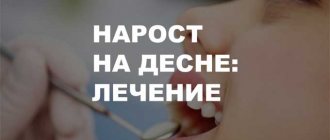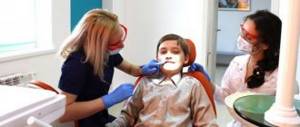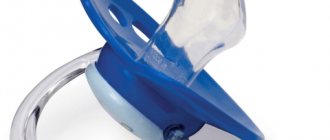What is a distal bite?
A synonymous name for this type of dentoalveolar curvature is “prognathia.” Its peculiarity is an imbalance in the development of the jaws, in which the lower jaw lags behind the upper jaw. At the same time, the teeth of the upper jaw protrude above the lower ones, and the chin is underdeveloped and seems small in comparison with other parts of the face. The general facial expression changes. A person with prognathia appears surprised or unhappy.
The often used term “deep distal bite” seems to us not entirely correct, since deep occlusion is an independent disorder that can develop in a patient as a result of his existing prognathism.
The severity of the distal bite can be determined by the closure of the sixth upper tooth with its “neighbor” located in the lower dentition. In the severe stage, the first large molar of the upper jaw comes into contact simultaneously with the large and small molars of the lower jaw. If the tooth comes into contact mainly with its antagonist, then the degree of violation is regarded as mild.
Treatment with Incognito braces
After stabilizing the lower jaw in its new position, the orthodontist took high-precision impressions, which were sent to the Incognito laboratory in Germany for the manufacture of customized braces. Before installing Incognito braces, the patient had permanent orthotics installed on her chewing teeth. Orthotics are needed to maintain the correct position of the lower jaw during treatment with braces.
Incognito braces on teeth - beginning of treatment:
Please note that braces are completely invisible from the outside; others may not even be aware that you are undergoing orthodontic treatment.
Orthodontic treatment with braces was successful. The patient visited the orthodontist once every two months. During these visits, the doctor monitored the changes taking place, changed the arches, and prescribed additional equipment (for example, orthodontic elastics to create physiological contacts between the teeth).
View 12 months after installing braces: the protruding tooth has returned to the dentition (shown in the photo with an arrow), the position of the lower teeth is approaching the result planned by the orthodontist. Let us remind you that there was no tooth extraction! All teeth are preserved!
22 months after braces are installed:
During the treatment, neuromuscular dentist A.V. Galeev monitored the functions of the orthotic, tracking the correct position of the lower jaw. The orthotic was periodically polished. The patient stated that the symptoms of TMJ dysfunction were a thing of the past.
Reasons for the formation of pathology
The development of dentofacial curvature is based on a hereditary predisposition, which is “layered” with damaging environmental factors. It also matters what affects the child during the period of intrauterine development, and the conditions under which the formation of the dental system occurs in the first years of life. The following three factors have the greatest influence.
Features of artificial feeding
When using special orthodontic nipples or when breastfeeding, the newborn has to make efforts to get milk. The tension of the facial muscles necessary for this stimulates the correct and uniform development of the jaws. When feeding from a bottle with a regular nipple, the baby practically does not strain. Because of this, the dental-jaw system lags significantly behind in development, which becomes the “background” for the development of various anomalies.
Nasal breathing disorder
The habit of breathing through the mouth leads to elongation and excessive increase in the size of the upper jaw, while the lower jaw lags behind it in proportions. According to statistics, diseases of the ENT organs are observed in every third child with a distal bite.
Violation of the process of changing teeth
Here, the cause of the development of prognathia may be the untimely loss of baby teeth due to injury or caries, improper eruption of permanent teeth, underdevelopment or lack of formation of permanent teeth. Unfortunately, many adults underestimate the importance of timely correction of primary and secondary dentition. As a result, where it was possible to get by with a temporary prosthesis, expensive braces have to be installed.
Children who do not have fangs on the lower jaw are at risk of developing prognathia. They have a malfunction of the articulatory apparatus, and the growth of the lower jaw slows down. Implantation can help in this situation.
Predisposing factors for the development of dentofacial pathology include cases of poor posture, rickets, the habit of thumb sucking, and the use of an irregularly shaped pacifier.
Choice of orthodontic treatment
Since there are so many orthodontic treatment options, there are many to choose from. However, this is not easy to do; you need to take into account a lot of indications and contraindications. A specialist should deal with this issue; the patient has the opportunity to express his preferences. But the final word should remain with the doctor.
- When correcting a child’s bite, removable structures are a very good option. A child's jaw is very pliable; it reacts even to minor mechanical influences of a short duration. Therefore, convenient removable structures can cope with malocclusion development;
- removable orthodontic aligners are an option for correcting minor bite defects. But the defect must be really insignificant, otherwise the mouth guards will be a waste of money. The decision should be left to the dentist;
- To correct a more or less formed bite, braces are the best option. Here the patient has a wide scope; he can choose the materials and type of construction himself. But some restrictions are still present. Despite their high aesthetics, lingual braces are not able to eliminate all dental defects. Sapphire and ceramic systems are fragile and therefore are not very effective against serious anomalies. The opinion of the attending physician when choosing a brace system should remain decisive;
- When correcting serious malocclusions, there are few treatment options. Most often this is a surgical intervention, supplemented by the subsequent wearing of braces;
- For children, functional methods are recommended to prevent malocclusions, as well as correct minor defects.
Methods for correcting distal bite
Approaches to correcting a developed disorder are determined by the severity of the pathology, the age of the patient and some other factors. The easiest way to eliminate the disorder is in children and adolescents whose jaw formation is ongoing or has recently ended. In adults, treatment can be carried out in several stages. Surgery may be necessary.
Treatment of prognathia in the primary and mixed dentition
In very young children, problems can be corrected with the help of vestibular plates and special bite formers. These devices eliminate pressure from the cheeks and lips on the developing dentition and help normalize breathing and swallowing.
In adolescents, it will be necessary to use functional guidance equipment: artificial crowns that are fixed on the lower chewing teeth and orthodontic structures with cervical traction. These devices look quite cumbersome and are inconvenient for the patient in everyday life, so they are used infrequently.
Braces can eliminate prognathism only at the dentoalveolar level: proper closure results from the movement of teeth on the jaw. If there is not enough space for the teeth in the dentition and they are crowded, then orthodontic treatment can be supplemented by the removal of one or more teeth.
A discrepancy between the sizes of the lower and upper jaws may be a consequence of excessive development of the upper jaw, a lag in the development of the lower jaw, or a combination of these two disorders. The non-removable Ainsworth apparatus, the Frenkel apparatus, helps correct the shape of the upper part. To accelerate the growth of the lower jaw, a pre-orthodontic trainer, palatal expander or removable plate apparatus is used.
Treatment of distal occlusion in adults
After the formation of the dentofacial system is completed, two approaches to correcting existing disorders can be used:
- Mask existing prognathia.
With the help of braces and transparent aligners, the position of the teeth on the jaw changes. One or more molars and molars are removed to give the remaining teeth enough space in the arch. In most cases, such camouflage can achieve the correct profile.
- Correction of distal occlusion surgically.
In severe cases, attempts to disguise the defect may not be successful. Orthognathic genioplasty surgery, during which the shape of the chin is corrected, will help you obtain a satisfactory result.
The result obtained in adulthood will have to be maintained all the time with the help of bite formers and special myogymnastic exercises that adjust the work of the masticatory and facial muscles to the new bite.
Start of bite correction
The first stage of treatment was performed by neuromuscular dentist A.V. Galeev. Using a computer myograph, he determined the correct position of the lower jaw.
This position was fixed using a specially made removable orthotic.
The patient wore a transparent mouthguard - orthotic - for about 6 months so that the muscles got used to the new position of the jaws. After some time, the neuromuscular dentist assessed the changes that had occurred, recording the new trajectory of movement and the final position of the lower jaw using special equipment.
Duration of treatment
The duration of correction is largely determined by the age of the patient. However, you must immediately prepare yourself for several months of wearing orthodontic structures. During the period of mixed dentition, children will have to wear special devices for a year and a half. In adults, wearing braces may take several years to obtain lasting results. However, a person quickly gets used to any devices and stops feeling them. And you shouldn’t refuse correction, since prognathia can lead to serious problems in the foreseeable future.
Stages of orthodontic treatment
- Diagnosis of malocclusions;
- X-ray examination of the jaw bones;
- selection of dental treatment methods and necessary orthodontic equipment;
- sanitation of the oral cavity, treatment of diseased teeth and gums, professional cleaning, etc.;
- installation of orthodontic apparatus;
- regular observation by a doctor, adjustment of the device;
- retention period to consolidate the achieved result;
- removal of orthodontic equipment.
Consequences of distal occlusion
Any violation of facial proportions removes a person’s appearance from the ideal of beauty and reduces his attractiveness. Insufficient development of the lower third of the face, an inexpressive chin, protruding teeth - all this creates an unfavorable impression of a person. In addition to this, other problems develop over time:
- diction suffers;
- the process of chewing food becomes difficult, which negatively affects the functioning of the entire digestive system;
- improper distribution of chewing load reduces the service life of teeth, leads to rapid abrasion of enamel, tooth loss due to inflammatory processes in the periodontium;
- pathological changes in the temporomandibular joints lead to the appearance of clicking sounds when chewing and become one of the causes of frequent headaches;
- If a patient has malocclusion, prosthetics becomes difficult, and the service life of crowns and dentures decreases.
Problems increase gradually, and their presence is not always associated with existing prognathia. However, it is better to think about your health when correction of the distal bite can be carried out as planned.
Ivanova Anastasia Vadimovna Orthodontist Work experience: 4 years
Services and prices
| Services | Price |
Distal bite
Distal bite – the upper front teeth are pushed forward in relation to the lower ones. A distinctive feature of such a bite is a discrepancy in size in the anteroposterior direction, in other words, either an overdeveloped upper jaw or an underdeveloped lower jaw.
The process of distributing the chewing load is disrupted. In this case, the back teeth will take on the load of the front teeth. In people with a distal bite, the back teeth will be more susceptible to tooth decay.
With this pathology, a person’s chin is disproportionately small, the face appears more childish and indecisive. After correcting the bite, the proportions of the face are aligned, the face acquires more correct proportions and appears more strong-willed.
Over many years, people usually adapt to life with a distal occlusion, and perhaps nothing bothers such a patient other than aesthetic inconsistency. But there comes a time when the distal bite begins to cause discomfort. Early development of periodontal diseases: periodontitis (inflammation of the gums) and periodontosis (loose teeth associated with pathological changes in the ligaments that hold the tooth in the bone and the bone itself), diseases of the temporomandibular joint, difficulties with prosthetics - these are some of the consequences of distal occlusion.
Distal bite is treated in different ways. In early childhood, removable appliances are used to restrain the growth of the upper jaw and stimulate the growth of the lower jaw. When such a device cannot be used (when jaw growth stops), then a bracket system is used. In this case, additional devices to the bracket system can be used.
Mesial bite
Mesial bite – the lower jaw protrudes forward.
Characterized by the anterior position of the lower jaw in relation to the upper. One of the hallmarks of a mesial bite is a protruding chin. Such a chin makes a young man’s face strong-willed and self-confident, but it is unlikely to beautify a girl.
The consequences of mesial occlusion, in addition to aesthetic inconsistency, are almost the same as with distal occlusion. Impaired chewing function, and as a result – the earlier development of periodontal diseases: periodontitis and periodontal disease, diseases of the temporomandibular joint, difficulties with prosthetics.
Treatment of mesial malocclusion is a very long process. The sooner a patient consults an orthodontist, the better, since jaw growth may be affected at an early age. If the upper jaw is underdeveloped, its growth must be stimulated; if the lower jaw is overdeveloped, you can try to restrain its growth. For this purpose, removable devices are used in childhood.
In adulthood, there are several treatment options for mesial malocclusion. These are orthognathic operations aimed at changing the position and size of the jaws and profile, as well as bite correction using a brace system with the possible removal of individual teeth.
Open bite
Open bite - the front or side teeth do not close together, forming a gap between them.
An open bite is a bite in which the teeth of the upper and lower jaws do not meet (do not contact). Pathology can be observed in the anterior and lateral sections; in the area of several teeth or a whole group of teeth.
The most obvious external manifestation of an open bite in the anterior region is a constantly slightly open mouth. A violation in only one of the lateral sections manifests itself in asymmetry of facial features.
In adult patients with established bad habits and formed jaws, it is necessary to use non-removable devices (braces), although it is worth recognizing that this form of pathology is one of the most difficult for orthodontists.
Deep bite
Deep bite - the incisors of the upper dentition overlap the incisors of the lower dentition by more than half, while the lower incisors do not rest on the dental cusps of the upper teeth.
Normally, the upper teeth should overlap the lower teeth by 1/3 of the length of the crown of the lower teeth. When the upper teeth overlap the lower teeth by more than half their length, then such a bite is considered deep. It can be deep not only in the front, but also in the lateral sections too.
With this type of bite, the face has insufficient height; the lower lip often turns outward, as there is not enough space for it. However, if a person tries to purse his lip, then the lips can be very thin. After treatment, the face acquires proportional dimensions, the upper lip stops turning outward. If a person purses his lips, then over time this habit goes away.
As a rule, the first object of damage in such a bite is the periodontium (the apparatus that holds the tooth in the bone); periodontal disease (loose teeth associated with pathological changes in the ligaments that hold the tooth in the bone and the bone itself), periodontitis (inflammation of the gums), and the mucous membrane The lining of the oral cavity suffers due to chronic dental trauma.
A common phenomenon with a deep bite is increased tooth wear. This in turn leads to changes in the tone of the masticatory muscles, which ultimately affects the temporomandibular joint (TMJ). Patients with a deep bite most often complain of crunching, clicking and pain in the joint. Sometimes damage to the TMJ can cause frequent headaches. There is no doubt that people with deep bites also have difficulties with prosthetics. Fixed and removable structures do not hold up well, they have to be changed frequently, which causes a lot of trouble for both the patient and the doctor.
Deep bite is often combined with other types of pathology, and most often with distal bite. Treatment of a deep bite will consist of increasing it using various devices from bite plates to a brace system.
Crossbite
Crossbite is a weak development of one side of either jaw.
Normally, all upper teeth should overlap the lower teeth in the anterior section by 1/3 of the length of the crown of the lower teeth, and in the lateral section, the outer cusps of the upper teeth should overlap the outer cusps of the lower teeth. Crossbite is a violation of this relationship of teeth in any direction. It can be unilateral or bilateral, it can be in the anterior and lateral sections.
In this malocclusion pathology, the chewing function suffers the most. Often such patients chew on one side. Those teeth that will take an active part in chewing are more susceptible to caries, and the early development of periodontal diseases (periodontal disease and periodontitis) is an indispensable companion to this form of pathology. With such uneven chewing, the temporomandibular joint (TMJ) often suffers, problems may arise when opening the mouth (crunching and restriction when opening), pain, which is often masked as a headache.
Subsequently, prosthetics with removable and non-removable structures will be very difficult for people with such pathology; fixed and removable structures do not hold up well and have to be changed frequently. Treatment of crossbite comes down to equalizing the size of the jaws, which can be achieved either with removable devices or with a brace system using additional devices to expand the jaws.











